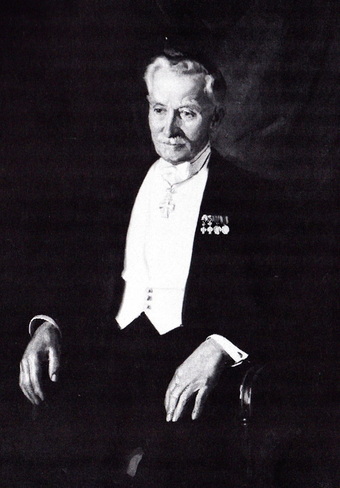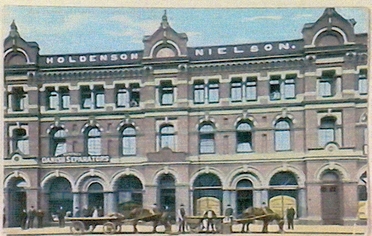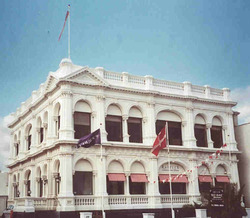poul John (P. J.) Holdenson (1863-1948)

Poul John (Jørgen) Holdenson started one of the first butter factories in
Victoria, which from its humble beginnings in a Melbourne market later became
the largest producer of butter in Australia and exporter to East Asia.
The firm of Holdenson and Nielsen was one of the major features of the Victorian dairying industry.
For many years, Holdenson was also the Danish Consul General in Victoria and had a major impact on the Danish Club and community in Melbourne.
The firm of Holdenson and Nielsen was one of the major features of the Victorian dairying industry.
For many years, Holdenson was also the Danish Consul General in Victoria and had a major impact on the Danish Club and community in Melbourne.
early years
Poul Jørgen Holdensen was born on 15 February 1863 in the small village of Sejstrup on the west coast of Jutland, Denmark. His parents were farm owner Holden Jensen Pedersen and Margrethe (nee Østergaard). His mother died when Holdenson was just 11 and his father remarried Lauridsine Marie (nee Christiansen) in 1875.
After finishing school, Holdenson started working on his father’s farm. At the young age of 16, being restless and hoping to earn enough money to buy his own farm in Denmark, he decided to go to Australia with his brother and a school-friend. The three young Danes left in 1879 and arrived in Victoria where they initially tried their hand at gold digging.
After finishing school, Holdenson started working on his father’s farm. At the young age of 16, being restless and hoping to earn enough money to buy his own farm in Denmark, he decided to go to Australia with his brother and a school-friend. The three young Danes left in 1879 and arrived in Victoria where they initially tried their hand at gold digging.
Building the dairy business
 The Holdenson and Nielson building in Flinders Street, Melbourne
The Holdenson and Nielson building in Flinders Street, Melbourne
Holdenson soon abandoned this gruelling task and became a farm hand. Having earned a few pounds, he subsequently bought a run-down restaurant in Melbourne, renovated it, turned it into a thriving business and sold it at a profit.
The money was used in part to buy a stall selling wholesale produce at Melbourne’s Eastern market, which turned out to be quite a success. The turning point in Holdenson’s career came when his old friend Andreas Nielson returned to Melbourne and suggested that they form a partnership focusing on dairy goods. The pair started one of the first ever butter factories in Melbourne in 1886, trading under the name of Holdenson and Nielson, collecting cream from the milk skimming stations set up in various country areas.
The company moved to Flinders Lane in 1889 and later to Flinders Street, whilst expanding throughout the state as the partners bought up several smaller and inefficient country butter factories. In 1902, Nielson had to return to Europe due to poor health (where he lated died in December 1903) and Holdenson took sole ownership of the business. In 1908, the business merged with Fresh Food Pty. Ltd to become Holdenson & Neilson Fresh Food Pty. Ltd. with Holdenson as the MD. Later, the firm became part of Petersville with Emil Christensen, Holdenson’s successor as Consul, as chairman.
The money was used in part to buy a stall selling wholesale produce at Melbourne’s Eastern market, which turned out to be quite a success. The turning point in Holdenson’s career came when his old friend Andreas Nielson returned to Melbourne and suggested that they form a partnership focusing on dairy goods. The pair started one of the first ever butter factories in Melbourne in 1886, trading under the name of Holdenson and Nielson, collecting cream from the milk skimming stations set up in various country areas.
The company moved to Flinders Lane in 1889 and later to Flinders Street, whilst expanding throughout the state as the partners bought up several smaller and inefficient country butter factories. In 1902, Nielson had to return to Europe due to poor health (where he lated died in December 1903) and Holdenson took sole ownership of the business. In 1908, the business merged with Fresh Food Pty. Ltd to become Holdenson & Neilson Fresh Food Pty. Ltd. with Holdenson as the MD. Later, the firm became part of Petersville with Emil Christensen, Holdenson’s successor as Consul, as chairman.
strong ties to denmark
On a personal note, Holdenson married Margrete Marie Hansen (who was born in Kyneton, Victoria of Danish immigrants) in 1890 in Castlemaine, Victoria. As many of his fellow Danish immigrants to Australia he also anglicised his name to Paul John Holdenson, or simply P.J. Holdenson.
In 1901, Holdenson was appointed Consul General for Denmark in Victoria.
He was an official guest at the opening of the first Commonwealth Parliament at the Exhibition Building in Melbourne in May of that year. Holdenson was a member of the Melbourne Chamber of Commerce and held board positions in various industrial and mining companies.
Many years later, in 1933, Holdenson was also made a Commander of the Order of Dannebrog primarily due to his deep involvement in the Danish Club in Melbourne and his efforts in maintaining a strong Danish identity in the 1920s and 1930s. He was President of the club on and off between 1911 and 1942 and was instrumental in creating a greater stability within the club.
In 1901, Holdenson was appointed Consul General for Denmark in Victoria.
He was an official guest at the opening of the first Commonwealth Parliament at the Exhibition Building in Melbourne in May of that year. Holdenson was a member of the Melbourne Chamber of Commerce and held board positions in various industrial and mining companies.
Many years later, in 1933, Holdenson was also made a Commander of the Order of Dannebrog primarily due to his deep involvement in the Danish Club in Melbourne and his efforts in maintaining a strong Danish identity in the 1920s and 1930s. He was President of the club on and off between 1911 and 1942 and was instrumental in creating a greater stability within the club.
Holdenson's legacy
 The majestic old 'Denmark House' in Melbourne
The majestic old 'Denmark House' in Melbourne
Holdensonn guaranteed the Danish Club's acquisition of the fine heritage-listed building on Beaconsfield Parade in 1938 which in recent years enabled the Club to solve its financial problems by selling the building for AUS$12 million which in turn resulted in the establishment of the Dannebrog Foundation. A painting of P.J. Holdenson by Sir William Dargie hangs in the Danish Club today.
He also contributed heavily to the Danish publication ‘Norden’ as well as the Danish church.
Holdenson died on 10 April 1948 in Melbourne at the age of 85.
He also contributed heavily to the Danish publication ‘Norden’ as well as the Danish church.
Holdenson died on 10 April 1948 in Melbourne at the age of 85.